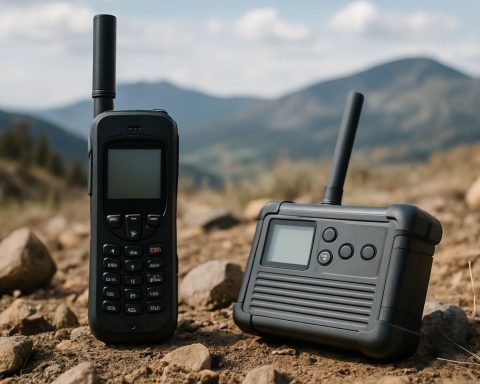- Autonomous Vehicles (AVs) are poised to transform rural transportation, addressing the gaps left by traditional systems.
- Ph.D. student Narayan Rai and Prof. Tom Shi are developing AVs that thrive in areas with scarce infrastructure, maps, and communication systems.
- The project concentrates on enhancing AV self-reliance and communication, aiming to build a robust ecosystem for seamless navigation.
- With $1.4 million funding from the U.S. Department of Transportation, the initiative is set to revolutionize rural mobility over six years.
- Collaborations with institutions like UW-Madison focus on making AVs accessible, especially for those unable to drive due to disabilities.
- The project’s success could inform urban adaptations, blending rural innovation with city infrastructure.
- Testing of full-sized vehicles will begin soon, emphasizing AVs’ potential for connection and empowerment in overlooked communities.
On the serene expanse of the University of Wisconsin-Milwaukee campus, a quiet revolution unfolds, driven not by a parade of gas-guzzling giants, but by a cluster of pint-sized robotic cars. Here, under the meticulous guidance of Ph.D. student Narayan Rai, these miniature, battery-powered vessels—each no longer than a ruler—are set to transform the landscape of autonomous transportation. Their soft whirring punctuates the air, echoing a future where self-driving vehicles promise to reshape not just urban jungles, but the vast, underserved stretches of rural America.
A world often ignored by traditional public transport systems, rural areas have been left yearning for viable commuting solutions. The dusty roads of these communities could soon witness the stealthy glide of autonomous vehicles (AVs), bridging the daunting distances to essential services like groceries or healthcare facilities. The mission has inspired Rai and his mentor, Prof. Tom Shi, from the university’s Civil and Environmental Engineering department, to challenge the limitations of current AV technology. Their vision is both ambitious and noble: to ensure these vehicles thrive where infrastructure is sparse, high-definition maps are rare, and communication systems falter.
Prof. Shi reveals the strategy behind their innovative approach. As well as enhancing AV systems to make them self-reliant, the team aims to supercharge the communication capacity of both the vehicles and their surroundings. The goal is to cultivate a robust ecosystem that supports sophisticated navigation—even amidst the cornfields and rolling hills of the American Midwest. Balancing these advancements with cost considerations, however, is a delicate dance. Shi and his team must tread carefully, ensuring their innovations remain accessible to both car manufacturers and the communities yearning for this transformation.
Buoyed by a generous $1.4 million injection from the U.S. Department of Transportation, this project heralds a six-year journey toward revolutionizing transportation. Its ripple effects engage a network of institutions—including UW-Madison and local collaborators—striving to converge on the solution. Another promising mind, Ph.D. student Muhammad Fahad, anchors part of the research in accessibility. His work promises newfound independence for individuals unable to drive due to disabilities. Just a mere tap on a mobile app, and a driverless vehicle arrives like a chariot from the future, carving a personalized path to freedom.
While public skepticism hovers over the notion of driverless cars, Prof. Shi remains optimistic, juxtaposing skepticism with the power of experience. When passengers taste the sweet relief of a reliable AV ride, initial doubts often melt away into trust. As cities continue to overflow, rural innovations might inform urban adaptation, creating a seamless tapestry of connectivity across diverse American landscapes.
As full-sized vehicles prepare for rigorous testing later this year, the message resonates with hopeful urgency: autonomous technology isn’t just about sophisticated software and advanced sensors. It’s about connection, empowerment, and redefining the contours of everyday life—especially for those in the often overlooked corners of our world.
Beyond the Horizon: Autonomous Vehicles Pave the Way for Rural Transformation
Unveiling the Untapped Potential of Autonomous Vehicles in Rural America
While the development of autonomous vehicles (AVs) often garners attention in relation to urban environments teeming with technological infrastructure, the significant potential for AVs in rural areas remains comparatively underexplored. The initiative led by Ph.D. student Narayan Rai at the University of Wisconsin-Milwaukee highlights this potential by focusing on transforming not just urban centers, but the underserved rural landscapes.
The Need for Autonomous Vehicles in Rural Areas
1. Addressing Transportation Deserts: Rural America often suffers from inadequate public transportation options, making AVs a promising solution to bridge the gap in access to essential services such as healthcare and grocery shopping.
2. Enhancing Accessibility: With over 19% of the U.S. population living in rural areas (U.S. Census Bureau), autonomous vehicles can drastically improve quality of life by offering reliable, affordable, and accessible transport solutions.
Innovative Approach to AV Development
– Self-Reliant Navigation: The team aims to enhance the self-reliance of AV systems, allowing them to function effectively in environments where high-definition maps are scarce.
– Advanced Communication Systems: A robust communication framework between AVs and their surroundings is crucial to navigate the expansive and less structured rural road networks.
Current Challenges and Future Solutions
– Cost vs. Innovation: Balancing technological advancements with cost efficiency is crucial to ensure widespread adoption across rural communities.
– Public Skepticism: Building trust in AV technology is essential, and real-world experiences demonstrating reliability are key to shifting perceptions.
Real-World Use Cases
1. Healthcare Access: Particularly for elderly or disabled residents, AVs can provide crucial access to medical services that are otherwise difficult to reach.
2. Agricultural Support: Farmers can leverage AV technology for logistical purposes, such as transporting goods efficiently to nearby markets or processing facilities.
Market Forecasts and Trends
The global autonomous vehicle market is estimated to reach a valuation of approximately $556 billion by 2026 (Allied Market Research). The integration of AVs in rural areas could spearhead a growth sector within this broader market, highlighting new revenue streams for manufacturers willing to engage with these communities.
Actionable Recommendations
1. Community Engagement: Actively involve rural residents in the conversation to understand their specific needs and challenges and customize solutions accordingly.
2. Incremental Implementation: Start small with pilot programs that demonstrate value and reliability.
3. Collaborations: Foster partnerships with tech providers, local governments, and community organizations to build an ecosystem supportive of AV technology.
Conclusion
Autonomous vehicles hold transformative potential for rural America, promising enhanced mobility, economic opportunity, and improved quality of life. By focusing on innovation that adapts to the unique challenges of these areas, the future of transportation might not only reshape urban landscapes but also breathe new life into rural communities.
For more information and updates on this topic, visit the University of Wisconsin-Milwaukee’s official site.












